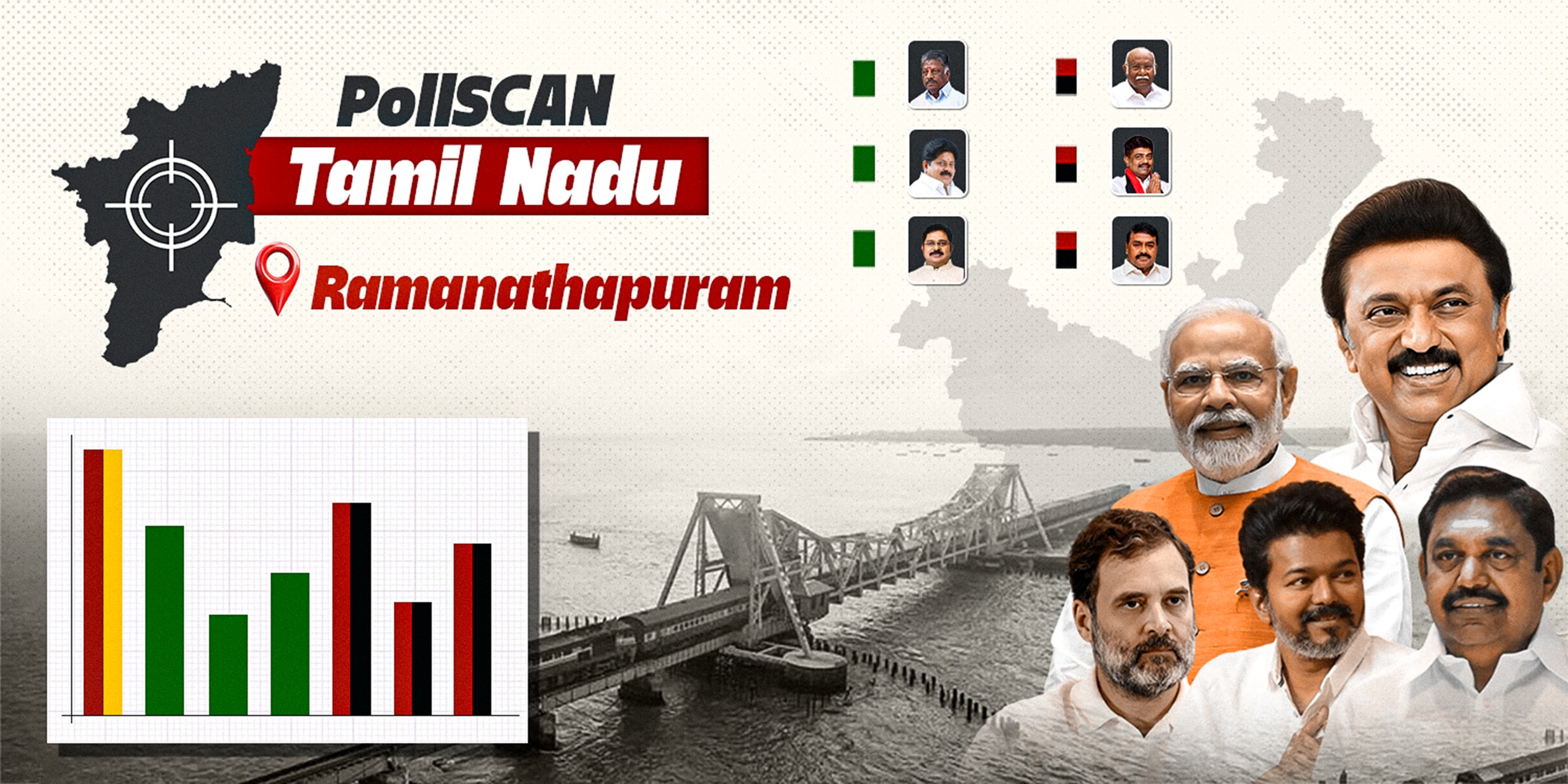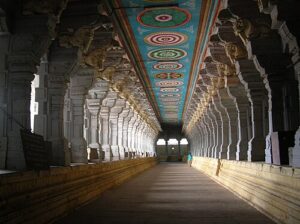Similar to Madurai, the Mukulathor community plays a decisive role in elections in Ramanathapuram. The district also remains a sensitive region due to frequent tensions between the Mukulathor and Devendrakula Velalar communities.
Published Aug 04, 2025 | 9:00 AM ⚊ Updated Aug 20, 2025 | 9:46 PM

Synopsis: The Ramanathapuram district has only four Assembly segments, though the Lok Sabha constituency has two more. Considered to be an AIADMK stronghold, the electorate is now facing a dilemma with O Pannerselvam’s exit from the NDA and his differences with TTV Dhinakaran. Even though Panneerselvam has not revealed his hand, TVK’s growing influence among the youth, and rumours of Vijay contesting from the district have made the run-up to the 2026 Assembly polls exciting.
Madras Assembly election, 1967. Fuelled by a formidable coalition, the DMK rode the anti-incumbency wave to power for the first time in Tamil Nadu.
Notable among the winners were R Srinivasan, who defeated K Kamaraj in Virudhunagar, and T Thangappan, who routed Shanmugha Rajeswara Sethupathi, the Raja of Ramanathapuram, by over 8,000 votes.
The election saw the rise of a new crop of politicians, the “organic intellectuals,” as Italian Marxist philosopher Antonio Gramsci would have preferred to describe them. The polls also marked the democratisation of inclusiveness in Tamil Nadu politics.
Thangappan’s win earned him the nickname, the “Julius Caesar of South India,” a title fondly given by C Rajagopalachari.

The Ramanathaswamy Temple boasts of having the longest corridor in Hindu temples in the country. (Wikimedia Commons)
Even before the 1967 elections, Ramanathapuram was not strange to India. Mythology has it that Lord Rama installed the Shiva linga and offered prayers at Rameswaram, before crossing the Rama Sethu to the island kingdom of Lanka to rescue Sita.
The Ramanathaswamy Temple is one of the Char Dham pilgrimage sites. It boasts of having the longest corridor in Hindu temples in the country.
Historically, the Ramanathapuram region was ruled by the Cholas, the Pandyas, and later by the Vijayanagara Empire, followed by the Sethupathi rulers. Even today, remnants of the royal past can be found in the district.
Also known as Ramnad or Mughavai district, Ramanathapuram holds strategic geographical importance, bordered by the Gulf of Mannar to the south and the Palk Strait to the east. It is a region often caught in geopolitical tension, particularly due to frequent conflicts between Rameswaram fishermen and the Sri Lankan Navy.
Ramanathapuram is also a significant tourist destination. Prime Minister Narendra Modi has often expressed a desire for visiting the district’s major landmarks, including the Ramanathaswamy Temple, the Pamban Bridge, and Dhanushkodi.
Though princely rule was abolished during the British era, the family of Shanmuga Rajeswara Sethupathi unofficially held sway over the Ramanathapuram region until 1967. Sethupathi himself was elected three times as an MLA from the Ramanathapuram constituency before 1967.
According to records, Sethupathi never campaigned door-to-door or requested votes directly. As a royal, he won with ease, until the 1967 election, when the DMK fielded a relatively unknown candidate, Thangappan, in Ramanathapuram.
Some accounts say Thangapandian was a horse cart, while others, including former AIADMK Minister A Anwhar Raajhaa, claimed that he had served in the army. Regardless of his background, the perception of Thangappan as a common man led Sethupathi to underestimate his opponent.
However, the election outcome was historic: Thangappan defeated the erstwhile royal and became the new MLA, marking the decline of both Congress and the Sethupathi family’s influence in the district.
Economically, Ramanathapuram district largely depends on maritime trade and agriculture. Politically, it has generally leaned in favour of the AIADMK more than the DMK.
Similar to Madurai, the Mukulathor community plays a decisive role in elections here. Ramanathapuram also remains a sensitive region due to frequent tensions between the Mukulathor and Devendrakula Velalar communities.
Comprising just four Assembly constituencies, Paramakudi (Reserved), Thiruvadanai, Ramanathapuram, and Mudukulathur, the district has a voter base of 11,97,228.
Ramanathapuram, the most prominent constituency in the district, has a total of 3,22,814 voters: 1,59,490 men, 1,63,311 women, and 13 others belonging to the third gender.
The current MLA from the constituency is Katharbatcha Muthuramalingam of the DMK. This is the same constituency where, in 1967, Thangappan defeated Shanmuga Rajeswara Sethupathi, who had continuously won from 1952 to 1962 as a Congress candidate.
However, from 1977 to 1984, the AIADMK dominated this seat. Out of the 16 Assembly elections held here so far, the AIADMK has won six times, and the DMK, five times. Others won in between.
Caste demographics play a decisive role in the constituency. The Mukulathor community comprises over 40 percent of the population, while Devendrakula Velalars constitute more than 20 percent. The fishing community and Muslims together account for over 15 percent, making these groups significant electoral forces.
Due to the dominant presence of the Mukulathor community, most parties tend to nominate candidates from this group. Both the current DMK MLA Muthuramalingam and the previous AIADMK MLA M. Manikandan belong to the Mukulathor community.
Historically, a united AIADMK stronghold, the constituency is now seeing a split in Mukulathor votes due to differences between O Panneerselvam and TTV Dhinakaran factions. This fragmentation could potentially benefit the DMK—especially with Panneerselvam’s recent exit from the BJP-led NDA.
Additionally, the substantial Muslim votes in the constituency may favour the DMK, giving the party an edge. However, a tight contest between the DMK and AIADMK is still likely.
At the same time, there are speculations that Tamilaga Vettri Kazhagam (TVK) leader and actor Vijay might contest from this constituency. Given his growing popularity among the fishing community, this possibility has gained traction.
In 2011, under the AIADMK government led by then Chief Minister J Jayalalithaa, Paramakudi witnessed a tragic incident that left a lasting impact on Tamil Nadu.
During a memorial event for Emmanuel Sekaran, a key leader of the Devendrakula Velalar community, a riot broke out, and the police opened fire on the crowd. The firing resulted in the deaths of a few people.
Paramakudi is a reserved constituency with a total of 2,56,771 voters, comprising 1,29,997 women, 1,26,751 men, and 23 others.
The current MLA is S Murugesan of the DMK. Despite this, the constituency has traditionally been considered a stronghold of the AIADMK, which—along with its allies—has won the majority of elections here.
The caste composition of Paramakudi is almost evenly split, with both the Mukulathor and Devendrakula Velalar communities accounting for more than 30 percent each. Additionally, the Yadav community makes up over 15 percent of the population.
With the AIADMK now split, a significant portion of Mukulathor votes may swing toward the DMK. Coupled with strong support from Devendrakula Velalars, the DMK is currently in a favorable position here. Unless the AIADMK reunifies, this will remain a difficult constituency for the party. Rebuilding trust with its once-loyal voter base will require the AIADMK to fight hard in this segment.
Furthermore, just like in other constituencies, TVK is gaining popularity among the youth here—especially among Devendrakula Velalar youth—indicating a possible shift in voter behaviour in the upcoming elections.
The Thiruvadanai Assembly constituency has long been considered favorable to the DMK and its allies, especially the Congress, which has recorded multiple victories here. The current MLA, RM Karumanickam, is from the Congress.
This constituency has a total of 2,99,606 voters—1,50,608 women, 1,48,971 men, and 27 voters from other categories. The Mukulathor community forms over 40 percent of the electorate and plays a decisive role in determining the outcome.
Scheduled Castes account for over 20 percent, while Muslims and other communities—including Pillai and Nadar voters—also reside in sizable numbers.
Given the weight of the Mukulathor vote, most parties field candidates from that community. In 2016, for instance, Karunas S, the leader of the Mukkulathor Pulipadai party (an AIADMK ally at the time), was elected.
With TTV Dhinakaran now heading his own party, the Amma Makkal Munnetra Kazhagam (AMMK), there is growing confusion among the AIADMK cadres. If Dhinakaran and the AIADMK contest together, a split may be minimised.
Otherwise, Thiruvadanai could become a major battleground between the DMK and AIADMK.
The Mudukulathur constituency carries the burden of a dark chapter in Tamil Nadu’s history. The infamous 1957 Mudukulathur riots—sparked by tensions between the Devendrakula Velalar and Mukulathor communities—remain a traumatic event.
Following the 1957 Assembly elections, peace talks were initiated, during which Devendrakula Velalar leader Immanuel Sekaran was murdered. The violence that ensued led to the deaths of more than 30 people, and thousands of homes belonging to the Devendrakula Velalar community were torched. The incident is recorded in history as one of the most violent and oppressive caste-based attacks in Tamil Nadu.
The constituency currently has 3,18,037 voters—1,59,654 women, 1,58,380 men, and 3 others.
The present MLA is RS Raja Kannappan, who also serves as the Minister for Forests and Khadi and Village Industries in the Tamil Nadu government.
The Mukulathor community constitutes about 40 percent of the population here, while Devendrakula Velalars account for about 30 percent. Other backward communities also reside in notable numbers.
Although both DMK and Congress have a stable vote base in the constituency, the final outcome will depend heavily on the candidate. Kannappan, being from the Yadav community, could become a determining factor.
If the opposition like the AIADMK, AMMK, and Tamil Makkal Munnetra Kazhagam (led by John Pandian, representing Devendrakula Velalars) join hands and field a candidate, the DMK could face a tough challenge here.
In Ramanathapuram, recurring issues faced by fishermen—such as frequent attacks by the Sri Lankan Navy, seizure of boats, and detention in Sri Lankan jails—remain unresolved despite repeated protests and demands for a permanent solution.
While Chief Minister MK Stalin has written to the central government seeking protection for the fishermen, locals feel the DMK government has not taken concrete steps. Additionally, there is a growing demand for more development projects in the region.
Within the DMK, tensions between key local leaders—MLA Muthuramalingam and Minister Kannappan—poses another challenge. If left unresolved, this internal rift could hinder the party’s prospects in the 2026 Assembly elections.
With Muslims accounting for 10–15 percent of the electorate, a significant portion of their votes is expected to go against the BJP alliance and in favor of the DMK. The recent defection of former AIADMK leader Anwar Raja to the DMK has also strengthened the party’s position in the district.
Panneerselvam faction’s exit from the BJP alliance, along with continued factionalism within the AIADMK, has created an unfavorable climate. Still, if the AIADMK and AMMK contest together, they are likely to retain a significant share of Mukulathor votes. The contests across constituencies will be tightly fought.
In all the four constituencies, TVK enjoys growing support among the youth—similar to other districts. With rumors that actor and TVK founder Vijay might contest from here, the party appears to be gaining ground. However, whether that support will translate into actual electoral victories remains to be seen.
(Edited by Majnu Babu).
